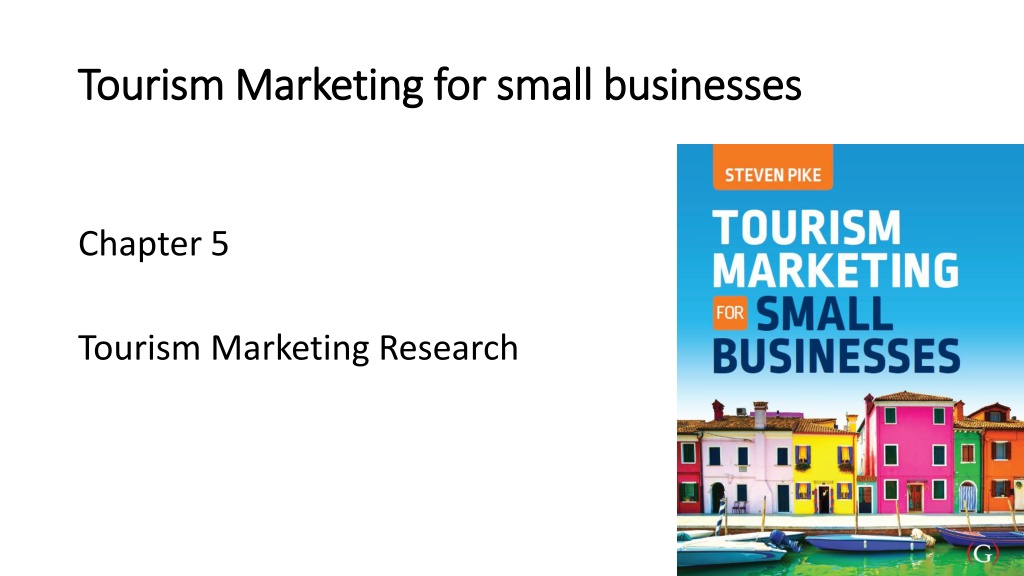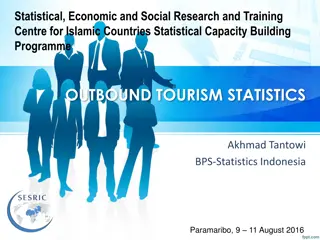Understanding Tourism Marketing Research for Small Businesses
Exploring the importance of marketing research in decision-making for tourism businesses, this chapter covers topics such as primary and secondary data, mixed research methods, stages of the research process, and identifying management decision problems. Marketing research is crucial for gaining valuable insights into customer needs and improving business strategies, even for small tourism ventures with limited resources.
Download Presentation

Please find below an Image/Link to download the presentation.
The content on the website is provided AS IS for your information and personal use only. It may not be sold, licensed, or shared on other websites without obtaining consent from the author. Download presentation by click this link. If you encounter any issues during the download, it is possible that the publisher has removed the file from their server.
E N D
Presentation Transcript
Tourism Marketing for small businesses Tourism Marketing for small businesses Chapter 5 Tourism Marketing Research
Chapter learning aims Chapter learning aims To enhance your understanding of: the role of marketing research in management decision making a six-step marketing research process the value of using a mixed methods research design
Key terms Key terms Primary data New data being collected for the first time for a specific purpose, through interacting with, and/or observing participants, using qualitative and/or or quantitative methods. Secondary data Existing data that has previously been collected for a purpose other than the current research project. Mixed methods A research design employing both qualitative and quantitative data collection methods.
The need for marketing research The need for marketing research A marketing orientation dictates decisions be made with target consumers in mind. This requires gathering information that will provide insights into the experience of current customers, and the needs of target consumers. Marketing research is an essential activity, even for small tourism businesses with limited resources, because information reduces uncertainty in decision making. However, marketing research is often under-utilised by small tourism businesses, due to lack of training, negative perceptions of the practical value, or perceived costs.
Marketing research defined Marketing research defined The process of designing, gathering, analysing, and reporting information that may be used to solve a specific marketing problem. (Burns, Veeck & Bush, 2017) This means any collection of information can be regarded as research including informal approaches such as talking to customers or suppliers.
Stages in the marketing research process Stages in the marketing research process 1..Identification of the marketing decision problem (MDP) 2. Formulation of the marketing research question (MRQ) 6. Interpretation and presentation of the findings 3. Research design 5. Data analysis 4. Data collection
Identifying the management decision problem Identifying the management decision problem (MDP) (MDP) The reason research is needed Defined in management terms Eg Should we change our brand slogan? Eg What price should we charge? Eg Is our advertising working? Critical stage of the MR process Inadequate problem definition is the main reason for MR failures
Common MDPs relate to: Common MDPs relate to: Improving profitability through increasing sales and/or reducing costs Improving promotion effectiveness Developing new markets/segments Developing and pricing new service offerings Improving service standards Identifying market characteristics Understanding consumer behaviour Analysing competitors
Formulating the marketing research question Formulating the marketing research question (MRQ) (MRQ) The MRQ is a broad and comprehensive description of the information required to make the management decision The MRQ should: Guide the researcher towards all information needed to address the management decision problem Assist the researcher in formulating the specific research objectives Suggest possible ways the data could be collected (the research design)
Relationship between MDP and MRQ Relationship between MDP and MRQ Marketing decision problem (MDP) Marketing research question (MRQ) Is there a problem with our service quality? What are the perceptions of our service quality by customers and non-customers? Develop packaging for new souvenir product How are alternative package designs perceived by consumers? Should we change the brand logo and slogan? How is the brand positioned, relative to competitors, in the minds of target consumers?
Relationship between MDP, MRQ and research Relationship between MDP, MRQ and research objectives objectives MDP Should the new product be launched in the market? MRQ What are consumer perceptions of the product? Research objectives 1. To identify consumer preferences for this type of product. 2. To identify consumers potential purchase intent for this type of product. 3. To identify the range of similar offerings by competitors.
Critical point Critical point The importance of asking the right question at the outset Getting the MDP and MRQ is critical to the success of the project, because they lay the foundation for the remaining stages. The best data collection and analysis will be meaningless if based on the wrong question. As Dr Karl Kruszelnichi reminds us: It s not the answer that gets you the prize, it s the question .
Ethics Ethics MR should be undertaken in an ethical manner, particularly during primary data collection when we are dealing with human beings. Codes of research ethics usually include the following principles (Jennings, 2001): Voluntary participation Informed consent The right to refuse to answer any question The right to withdraw at any time Confidentiality Participants access to the findings
Research design Research design The research design sets out the collection of primary and secondary data that will generate information to address the marketing decision problem. A search of secondary data is the starting point in any MR project Existing data that has previously been collected Eg Government Census data, news media, DMO websites, industry reports, academic literature We might find some or all of the information we need already exists Helps us find out how others have designed their research
There is nothing so practical as good theory There is nothing so practical as good theory Marketing research is underpinned by theory. The value of reviewing the academic literature can guide us about theories relevant to our marketing research question (MRQ). If our MRQ contains a construct, such as brand awareness or market position, for example, we can look for a theory that will guide our research design. A theory is practical when it helps determine how the construct can be measured.
Mixed methods Mixed methods Employing both qualitative and quantitative data collection methods Provides a greater depth and breath of data A qualitative stage (eg personal interviews) can be used prior to the development of a questionnaire, to help us understand key issues in the language of the consumer A qualitative stage can be used following the questionnaire data collection, to tease out unexpected findings
Characteristics of qualitative and quantitative Characteristics of qualitative and quantitative research methods research methods Qualitative research To find meaning in a phenomenon or situation from an inside perspective. Relatively small in number. Non-probability methods. Not representative of the wider population of interest. Unstructured or semi- structured data collection, through personal interviews, focus groups, or observation. Non-numerical. Subjective interpretation. Quantitative research Purpose To measure the phenomenon or situation and generalise results to the wider population of interest. Relatively large in number. Probability methods. Representative of the wider population of interest. Sample Methods Structured data collection, through observation, surveys, or experiments. Data Data analysis Numerical. Objective statistical analysis. Outcome An initial understanding of a situation, which may be tested through quantitative research. Marketing implementation recommendations.
Practical tourism applications Identifying items to include in a questionnaire. Testing creative concepts such as new branding, advertising and packaging. Exploring views and price impressions for a new product. Generating new ideas for an old product. Exploring motivations for an activity. Observing a phenomenon, such as queueing for service. Exploring barriers to purchase by non- customers. Exploring issues that emerged from a questionnaire. Measuring: - brand awareness - brand positioning - brand loyalty - service quality - customer satisfaction - differences between groups Identifying different segments in the population. Identifying associations between variables.
Limitations Limitations All MR projects have limitations Rarely will the information collected be perfect for solving the MDP The characteristics of the sample may not be completely representative of the wider population of interest. The results are what participants have stated, such as purchase intent for example, but do not measure actual behaviour. Studies that measure both stated intent and actual behaviour are rare. Most studies are in the form a snapshot at one point in time, and results might be different if investigated at another time. Longitudinal studies, which involve multiple surveys of the same participants over time, are rare.
Discussion questions Discussion questions Why is it essential that all tourism business owners and marketing managers have an understanding of the principles of marketing research? How would you decide whether to use a qualitative or quantitative stage in the research design? Explain why it is acceptable to acknowledge the limitations of the findings in a marketing research project to stakeholders, such as management, staff, investors or financiers?























